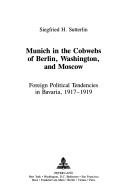
Munich in the cobwebs of Berlin, Washington, and Moscow
By Siegfried H. Sutterlin
Subjects: Peace, Diplomatic history, Politics and government, World War, 1914-1918, Foreign relations, Bavaria (germany), politics and government, World war, 1914-1918, peace, World war, 1914-1918, diplomatic history
Description: This monograph is a standard one, but the preface and introduction are the result of a first rate synthesis and a profound grasp and understanding of the vast sweep of diplomatic/political history throughout the 20th century. It would suffice to read the preface and intro for those who get tired of plowing through the minutiae of microhistory and prefer to be enlighten by an attractive and condensed historical synthesis. The author shows an unusual insight into how current U.S. problems relate to and emerged from what transpired when Wilsonism and Leninism emerged in l9l7 and how the ebb and flow of history fluctuated between Germany, the U.S., and other nations. This book has an excellent conceptualization and shows profound historical understanding but its overall quality is somewhat weakened by the narration of the actual story. Hitler was in Munich in 1918/19. The Nazi party originated there at that time. Sutterlin's book does not deal with Hitler or the party. But in a shrewd conceptualization his brief study concentrates on the diplomatic, socio-economic and political framework against which Hitler and his party emerged. He starts with the year 1917 which witnessed the birth of Leninism in Russia and the U.S. entry into World War I. As the author states in the introduction, Leninism competed with Wilsonism and Wilsonism with Leninism and both impacted decisively on Bavarian foreign policy to create a degree of fluidity allowing political opportunists to exploit it for their purposes. Exhaustively using primary sources from Bavarian archives and State Department diplomatic documents, Sutterlin paints a tapestry of the milieu in which royalists, veterans, 'peaceniks,' 'hippies,' poets, prophets, professors, students, artists, literati, long-haired, bearded editors and Bohemians of one sort or another exploited World War I and its post-war dislocations. They looked toward Washington and Wilson and then toward Moscow and Lenin to escape the centralizing tendency of Berlin. Thus, this study deals with another conceptual framework -- the Old and New Diplomacy which briefly manifested itself in Bavaria in a classic fashion. Beyond that, it also deals with the primacy of foreign policy over domestic policy, the issue of decentralization versus centralization in German constitutional history and the emergence of the Weimar Republic which demolished German federalism. This is also a book for readers interested in comparing the peace movement during the First World War with the peaceniks during the Vietnam War. The similarities as Sutterlin describes them are astounding. The Bohemians in Munich proclaimed the 'nationalization' of women, did away with all titles, and enacted other utopian policies not unlike the flower children of the 1960s.
Comments
You must log in to leave comments.